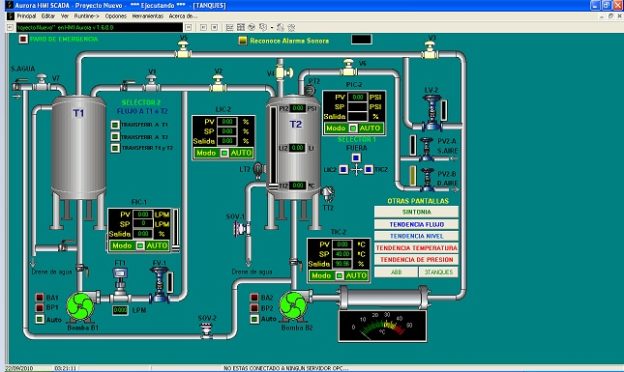
SCADA:`
Doing SCADA “right” usually involves understanding the underlying physical process that is monitored and controlled by the system and adapting the SCADA system to suit the needs of that process. This can include process safety, integrity and security, modes of failure, etc.
In simple terms the SCADA system typically is the master system over a real-time system(s). A typical model of communication in SCADA is: (controller, sensor, actuator) <-> (OPC server(s)) <-> (SCADA application) <-> (sometimes presentation of selected parameters via the Internet).
The SCADA Systems were conventionally more geared towards only Monitoring and Control operations. However modern SCADA systems do come with more advanced features like Data Collection, Reporting and Scripting capabilities to achieve functions like Integration with Production Management Systems etc.
SCADA systems are crucial for industrial organizations since they help to maintain efficiency, process data for smarter decisions, and communicate system issues to help mitigate downtime.
The basic SCADA architecture begins with programmable logic controllers (PLCs) or remote terminal units (RTUs). PLCs and RTUs are microcomputers that communicate with an array of objects such as factory machines, HMIs, sensors, and end devices, and then route the information from those objects to computers with SCADA software. The SCADA software processes, distributes, and displays the data, helping operators and other employees analyze the data and make important decisions.
For example, the SCADA system quickly notifies an operator that a batch of product is showing a high incidence of errors. The operator pauses the operation and views the SCADA system data via an HMI to determine the cause of the issue. The operator reviews the data and discovers that Machine 4 was malfunctioning. The SCADA system’s ability to notify the operator of an issue helps him to resolve it and prevent further loss of product.
ERP: Business Practice Automation
ERP is essentially a reporting technology, a way to store and share large volume of information in accessible form. ERP systems help connect the wider-enterprise, allowing for resource capacity planning, job costing, asset tracking, and providing an array of business value, in terms of:
The ERP field can be slow to change, but the last couple of years have unleashed new technology trends which are fundamentally shifting the entire area. The following new and continuing computing trends have an impact on the growth of enterprise ERP software:
Executives and employees want real-time access to information, regardless of where they are. It is expected that businesses will embrace mobile ERP for the reports, dashboards and to conduct key business processes.
The cloud has been advancing steadily into the enterprise for some time, but many ERP users have been reluctant to place data cloud. Those reservations have gradually been evaporating, however, as the advantages of the cloud become apparent.
There has been much hype around social media and how important —or not — it is to add to ERP systems. Certainly, vendors have been quick to seize the initiative, adding social media packages to their ERP systems with much fanfare. But some wonder if there is really much gain to be had by integrating social media with ERP.
Enterprises once attempted to build an all-encompassing ERP system to take care of every aspect of organizational systems. But some expensive failures have gradually brought about a change in strategy – adopting two tiers of ERP.
MES: Manufacturing Execution Foundation
MES allows companies to track and monitor just about every aspect of their manufacturing processes, in terms of:
MES enables manufacturers to overcome the challenge of regulatory compliance set by the Food and Drug Administration (FDA) for regulated industries such as pharmaceuticals, food and beverage, medical device class, and biotechnology, as well as biologic developers and contract research organizations.
MES maintains an “as-built” or device history record (DHR) for each product unit and batch by collecting data, processes and outcomes of the manufacturing process for compliance with Title 21 CFR Part 11 and Part 820 of the FDA regulations.
Additionally, an MES can benefit both discrete manufacturing for industries such as aerospace, defense and automotive, and process manufacturing for chemical, oil and gas, power and energy, and pulp and paper industries.
IIoT:
IoT or IIoT (Industrial Internet of Things) is much more related to long time data storage for analysis and comparison with different solutions than to the day-by-day operation of the plant.
Inter-operability and security are probably the two biggest challenges surrounding the implementation of IIoT. As technology writer Margaret Rouse observes, “A major concern surrounding the Industrial IoT is interoperability between devices and machines that use different protocols and have different architectures.” Ignition is an excellent solution for this since it is cross-platform and built on open-source, IT-standard technologies.
Companies need to know that their data is secure. The proliferation of sensors and other smart, connected devices has resulted in a parallel explosion in security vulnerabilities. This is another factor in the rise of MQTT since it is a very secure IIoT protocol.